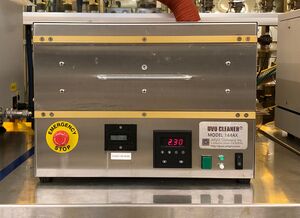UV Ozone Reactor: Difference between revisions
Jump to navigation
Jump to search
m (bullet list) |
(Added an SOP) |
||
| (7 intermediate revisions by 4 users not shown) | |||
| Line 1: | Line 1: | ||
{{ |
{{tool2|{{PAGENAME}} |
||
|picture=Ozone.jpg |
|picture=Ozone.jpg |
||
|type = Dry Etch |
|type = Dry Etch |
||
|super= |
|super= Lee Sawyer |
||
|super2= Tony Bosch |
|||
|model=144AX |
|||
|location=Bay 5 |
|location=Bay 5 |
||
|description = |
|description = UV Ozone Cleaner |
||
|manufacturer = |
|manufacturer = Jelight |
||
}} |
}} |
||
== |
==About== |
||
UV+O (atomic oxygen) cleaning method is a photosensitized oxidation process in which the contaminant molecules of photo-resists, resins, human skin oils, cleaning solvent residues, silicone oils, and flux are excited and/or dissociated by the absorption of short-wavelength UV radiation. Near atomically clean surfaces can be achieved in less than one minute. In addition, this process does not damage any sensitive device structures of MOS gate oxide. The system can be used for oxygen activation, etching or oxidation of a surface without ion bombardment. |
|||
==Documentation== |
|||
== Operating Procedures == |
|||
* [[UV Ozone Quick Start|Quick Start]] |
|||
*[https://wiki.nanofab.ucsb.edu/w/images/3/3e/UV_Ozone_SOP_Rev_A.pdf UV Ozone Reactor SOP] |
|||
* [Media:UV Ozone Manual Jelight M-144AX.pdf] |
|||
*[//wiki.nanotech.ucsb.edu/wiki/images/7/79/UV_Ozone_Manual_Jelight_M-144AX.pdf UV Ozone Manual] |
|||
Latest revision as of 16:17, 29 August 2023
| ||||||||||||||||||||||||||||
About
UV+O (atomic oxygen) cleaning method is a photosensitized oxidation process in which the contaminant molecules of photo-resists, resins, human skin oils, cleaning solvent residues, silicone oils, and flux are excited and/or dissociated by the absorption of short-wavelength UV radiation. Near atomically clean surfaces can be achieved in less than one minute. In addition, this process does not damage any sensitive device structures of MOS gate oxide. The system can be used for oxygen activation, etching or oxidation of a surface without ion bombardment.
